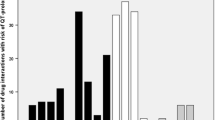Abstract
Background Citalopram and escitalopram can both induce dose-dependent QT prolongation. The risk of arrhythmia may be increased with concomitant use of other drugs that induce QT prolongation. Objective To evaluate the prevalence and impact of pharmacist interventions on the combination of citalopram or escitalopram with other drugs that induce QT prolongation. Setting A French hospital with 517 computerized beds. Method All cardiac adverse drug reactions (ADRs) related to citalopram or escitalopram reported to the French pharmacovigilance database (FPDB) were analyzed. Then, over a 6-month period, all computerized prescriptions including citalopram or escitalopram and drug–drug interactions (DDI) were analyzed by pharmacists using a computerized provider order entry system (DXCare®, Medasys). Results Only 27 cardiac ADRs related to citalopram or escitalopram were reported in the database. Among the 57,857 prescriptions and 2116 contraindicated DDIs (3.7 %) that were analyzed. 444 DDIs (0.8 %) were considered to be clinically relevant by pharmacists and physicians and 168 (i.e., approximately 30 %) were related to a combination including citalopram or escitalopram. Most of the prescriptions related to DDIs including citalopram or escitalopram were discontinued in response to a pharmacist intervention when initiated during the hospital stay. Conclusion A high number of hospital prescriptions including citalopram or escitalopram with another QT-prolonging drug occurred, highlighting the importance of involvement of clinical pharmacists in prevention of potential ADRs related to such contraindications.


Similar content being viewed by others
References
Sultana J, Cutroneo P, Trifiro G. Clinical and economic burden of adverse drug reactions. J Pharmacol Pharmacother. 2013;4(Suppl 1):S73–7.
Sikdar KC, Dowden J, Alaghehbandan R, MacDonald D, Peter P, et al. Adverse drug reactions in elderly hospitalized patients: a 12-year population-based retrospective cohort study. Ann Pharmacother. 2012;46(7–8):960–71.
Tache SV, Sonnichsen A, Ashcroft DM. Prevalence of adverse drug events in ambulatory care: a systematic review. Ann Pharmacother. 2011;45(7–8):977–89.
Bouvy JC, De Bruin ML, Koopmanschap MA. Epidemiology of adverse drug reactions in Europe: a review of recent observational studies. Drug Saf. 2015;38(5):437–53.
Lazarou J, Pomeranz B, Corey P. Incidence of adverse drug reactions in hospitalized patients: a meta-analysis of prospective studies. JAMA. 1998;79:1200–5.
Trifiro G, Pariente A, Coloma PM, Kors JA, Polimeni G, et al. Data mining on electronic health record databases for signal detection in pharmacovigilance: which events to monitor? Pharmacoepidemiol Drug Saf. 2009;18(12):1176–84.
Lam R. Antidepressants and QTc prolongation. J Psychiatry Neurosci. 2013;38(2):E5–6.
Hasnain M, Howland RH, Vieweg WV. Escitalopram and QTc prolongation. J Psychiatry Neurosci. 2013;38(4):E11.
Álvarez E, Vieira S, Garcia-Moll X. Citalopram, escitalopram and prolonged QT: warning or alarm? Rev Psiquiatr Salud Ment. 2014;7(3):147–50.
Coughtrie A, Behr E, Layton D, Marshall V, Camm AJ, et al. Drugs and life-threatening ventricular arrhythmia risk: results from the DARE study cohort. BMJ Open. 2017;7(10):e016627.
Leape LL, Bates DW, Cullen DJ, Cooper J, Demonaco HJ, et al. Systems analysis of adverse drug events. ADE Prevention Study Group. JAMA. 1995;274(1):35–43.
Johnell K, Klarin I. The relationship between number of drugs and potential drug-drug interactions in the elderly: a study of over 600,000 elderly patients from the Swedish Prescribed Drug Register. Drug Saf. 2007;30(10):911–8.
Barrons R. Evaluation of personal digital assistant software for drug interactions. Am J Health Syst Pharm. 2004;61(4):380–5.
Kannry J. Effect of e-prescribing systems on patient safety. Mt Sinai J Med. 2011;78(6):827–33.
Kaushal R, Kern LM, Barron Y, Quaresimo J, Abramson EL. Electronic prescribing improves medication safety in community-based office practices. J Gen Intern Med. 2010;25(6):530–6.
Nuckols TK, Smith-Spangler C, Morton SC, Asch SM, Patel VM, et al. The effectiveness of computerized order entry at reducing preventable adverse drug events and medication errors in hospital settings: a systematic review and meta-analysis. Syst Rev. 2014;3:56.
Footracer KG. Alert fatigue in electronic health records. JAAPA. 2015;28(7):41–2.
Bates DW, Leape LL, Cullen DJ, Laird N, Petersen LA, et al. Effect of computerized physician order entry and a team intervention on prevention of serious medication errors. JAMA. 1998;280(15):1311–6.
Bobb A, Gleason K, Husch M, Feinglass J, Yarnold PR, et al. The epidemiology of prescribing errors: the potential impact of computerized prescriber order entry. Arch Intern Med. 2004;164(7):785–92.
Anthierens S, Tansens A, Petrovic M, Christiaens T. Qualitative insights into general practitioners views on polypharmacy. BMC Fam Pract. 2010;11:65.
Yap YG, Camm AJ. Drug induced QT prolongation and torsades de pointes. Heart. 2003;89(11):1363–72.
Tampi RR, Balderas M, Carter KV, Tampi DJ, Moca M, et al. Citalopram, QTc prolongation, and torsades de pointes. Psychosomatics. 2015;56(1):36–43.
Funk KA, Bostwick JR. A comparison of the risk of QT prolongation among SSRIs. Ann Pharmacother. 2013;47(10):1330–41.
Wisniowska B, Tylutki Z, Wyszogrodzka G, Polak S. Drug-drug interactions and QT prolongation as a commonly assessed cardiac effect—comprehensive overview of clinical trials. BMC Pharmacol Toxicol. 2016;17:12.
Li M, Ramos LG. Drug-induced QT prolongation and torsades de pointes. P T. 2017;42(7):473–7.
Hazell L, Shakir SA. Under-reporting of adverse drug reactions: a systematic review. Drug Saf. 2006;29(5):385–96.
Pushkin R, Frassetto L, Tsourounis C, Segal ES, Kim S. Improving the reporting of adverse drug reactions in the hospital setting. Postgrad Med. 2010;122(6):154–64.
Khan SA, Goyal C, Chandel N, Rafi M. Knowledge, attitudes, and practice of doctors to adverse drug reaction reporting in a teaching hospital in India: an observational study. J Nat Sci Biol Med. 2013;4(1):191–6.
Allen LaPointe NM, Curtis LH, Chan KA, Kramer JM, Lafata JE, et al. Frequency of high-risk use of QT-prolonging medications. Pharmacoepidemiol Drug Saf. 2006;15(6):361–8.
Meid AD, Bighelli I, Machler S, Mikus G, Carra G, et al. Combinations of QTc-prolonging drugs: towards disentangling pharmacokinetic and pharmacodynamic effects in their potentially additive nature. Ther Adv Psychopharmacol. 2017;7(12):251–64.
Acknowledgements
None.
Author information
Authors and Affiliations
Corresponding author
Ethics declarations
Conflicts of interest
The authors declare no conflicts of interest.
Funding
None to declare.
Rights and permissions
About this article
Cite this article
Chastang, A., Renet, S., Corny, J. et al. Impact of hospital pharmacist interventions on the combination of citalopram or escitalopram with other QT-prolonging drugs. Int J Clin Pharm 41, 42–48 (2019). https://doi.org/10.1007/s11096-018-0724-7
Received:
Accepted:
Published:
Issue Date:
DOI: https://doi.org/10.1007/s11096-018-0724-7




